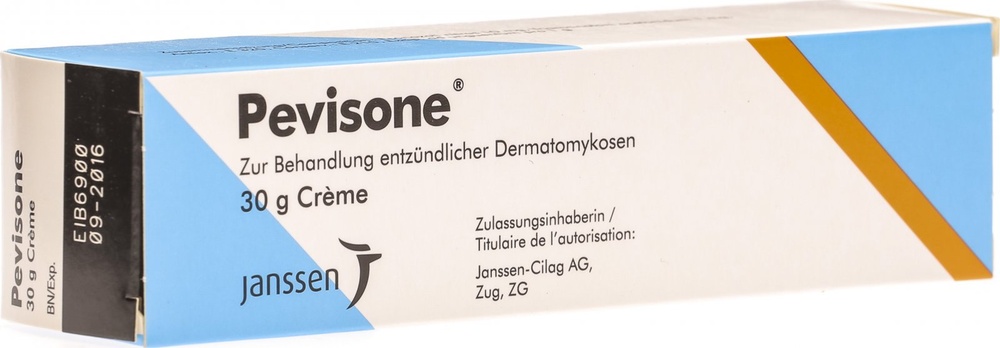

Pevisone

Ask a doctor about a prescription for Pevisone

How to use Pevisone
Leaflet attached to the packaging: patient information
PEVISONE, (10 mg + 1.1 mg)/g, cream
Econazole nitrate + Triamcinolone acetonide
Please read carefully the contents of the leaflet before using the medicine, as it contains important information for the patient.
- Please keep this leaflet, so you can read it again if you need to.
- If you have any doubts, you should consult a doctor, pharmacist, or nurse.
- This medicine has been prescribed specifically for you. Do not pass it on to others. The medicine may harm another person, even if their symptoms are the same.
- If the patient experiences any side effects, including any side effects not listed in this leaflet, they should inform their doctor, pharmacist, or nurse. See section 4.
Table of contents of the leaflet:
- 1. What is Pevisone and what is it used for
- 2. Important information before using Pevisone
- 3. How to use Pevisone
- 4. Possible side effects
- 5. How to store Pevisone
- 6. Contents of the packaging and other information
1. What is Pevisone and what is it used for
The active substances of Pevisone are econazole, in the form of econazole nitrate, and triamcinolone, in the form of triamcinolone acetonide.
Econazole nitrate is a topical antifungal medicine, a derivative of triazole.
Triamcinolone acetonide is a moderately potent anti-inflammatory corticosteroid. When used topically, it has anti-inflammatory, anti-pruritic, and vasoconstrictive effects.
Indications for use of Pevisone:
Treatment of fungal skin infections caused by dermatophytes and yeasts with significant signs of inflammation.
2. Important information before using Pevisone
When not to use Pevisone
- if the patient is allergic to econazole or triamcinolone, or any of the other ingredients of this medicine (listed in section 6),
- if the patient has bacterial skin infections (e.g., tuberculosis),
- if the patient has viral skin infections (e.g., chickenpox, herpes),
- if the patient has post-vaccination reactions.
Warnings and precautions
Before starting treatment with Pevisone, the patient should discuss it with their doctor.
Pevisone is intended for external use only. The medicine should not be used in the eyes, on the eyelids, or orally.
If significant irritation or allergic reaction occurs, treatment should be discontinued.
Topical corticosteroids may be absorbed in sufficient amounts to cause systemic effects, including adrenal suppression. Systemic absorption may increase due to several factors, such as: application to large skin areas, damaged skin, under occlusive dressings, and prolonged treatment duration.
The medicine should not be used in children under 16 years of age.
In children, due to the larger ratio of body surface area to body mass, it is easier than in adults to cause suppression of the hypothalamic-pituitary-adrenal axis and the occurrence of side effects characteristic of corticosteroids, including growth and development disorders.
Care should be taken when using Pevisone in children over 16 years of age, and treatment should be discontinued if signs of adrenal suppression or Cushing's syndrome occur.
Repeated and/or prolonged topical use of corticosteroids in the eye area may cause cataracts, increased intraocular pressure, or increase the risk of cataracts.
During the use of topical corticosteroids, the following have been reported: skin atrophy, striae, rosacea, perioral dermatitis, acne, telangiectasia, hypertrichosis, and delayed wound healing.
Topical corticosteroids may increase the risk of recurrent skin infections and infections caused by microorganisms that do not normally cause disease in healthy individuals.
Using the medicine too frequently, on large skin areas, or in an improper manner for a long time may lead to the occurrence of withdrawal symptoms after treatment is discontinued (see sections 2 and 4). The patient should consult their doctor for advice.
If the disease recurs soon after stopping treatment, the patient should not restart using the cream without consulting their doctor, unless the doctor has previously advised otherwise.
If the disease has resolved, but upon recurrence, the redness spreads beyond the initial treatment area and burning occurs, the patient should consult their doctor before restarting treatment.
Children and adolescents
The medicine should not be used in children under 16 years of age.
Pevisone and other medicines
The patient should inform their doctor or pharmacist about all medicines they are currently taking or have recently taken, as well as any medicines they plan to take.
Despite the limited systemic effect of econazole when applied topically, clinically significant interactions may occur, as observed during the use of oral anticoagulant medicines. If the patient is taking oral anticoagulant medicines, such as warfarin or acenocoumarol, they should inform their doctor, who will monitor the anticoagulant effect.
Pregnancy and breastfeeding
If the patient is pregnant, thinks they may be pregnant, or plans to have a child, they should consult their doctor or pharmacist before using this medicine.
Pregnancy
In the first trimester of pregnancy, Pevisone can be used only if the doctor considers it necessary. During the second and third trimesters of pregnancy, Pevisone can be used if the doctor believes that the potential benefits to the mother outweigh the possible risks to the fetus.
During pregnancy, the medicine should not be used in large doses, under occlusive dressings, or for a prolonged period.
Breastfeeding
If the patient is breastfeeding, they should consult their doctor or pharmacist before using this medicine.
Driving and using machines
No effects of Pevisone on the ability to drive and use machines have been observed.
Pevisone contains butylhydroxyanisole and benzoic acid
Due to the presence of butylhydroxyanisole (E 320), the medicine may cause local skin reactions (e.g., contact dermatitis) or eye and mucous membrane irritation.
The medicine contains 2 mg of benzoic acid (E 210) per gram of cream, which corresponds to 30 mg of benzoic acid per 15 g tube. Benzoic acid may cause local irritation.
3. How to use Pevisone
This medicine should always be used as directed by the doctor. If the patient has any doubts, they should consult their doctor.
Pevisone should be rubbed into the infected skin areas no more than twice a day, preferably in the morning and evening. The medicine should not be used under occlusive dressings or on large skin areas.
Treatment should continue until the inflammatory symptoms resolve, but no longer than 2 weeks. After 2 weeks of using Pevisone, the doctor may, if necessary, recommend continuing treatment with another medicine containing only econazole.
Using Pevisone too frequently, on large skin areas, or in an improper manner for a long time may lead to the occurrence of withdrawal symptoms, especially after sudden treatment discontinuation (see sections 2 and 4). The patient should consult their doctor for advice.
Use in children and adolescents
The medicine should not be used in children under 16 years of age.
Using a higher dose of Pevisone than recommended
In case of using a higher dose than recommended, the patient should contact their doctor.
Missing a dose of Pevisone
The patient should use the medicine as soon as possible and apply the next dose at the usual time.
The patient should not use a double dose to make up for a missed dose.
If the patient has any further doubts about using this medicine, they should consult their doctor or pharmacist.
4. Possible side effects
Like all medicines, Pevisone can cause side effects, although not everybody gets them.
In clinical trials of Pevisone, 1.6% of adult patients experienced skin burning sensation and skin irritation, and 1.0% of children experienced redness.
The following side effects have been observed during the use of Pevisone, during clinical trials and after marketing :
Common side effects (occurring in no more than 1 in 10 people):
Redness, burning sensation, skin irritation.
Very rare side effects (occurring in less than 1 in 10,000 people):
Angioedema (sudden swelling of the face or throat, making it difficult to speak, swallow, or breathe) - in case of such side effects, the patient should immediately inform their doctor or go to the emergency department of the nearest hospital.
In addition, the following very rare side effects may occur:
Hypersensitivity (allergy), contact dermatitis, skin atrophy, pruritus, desquamation, striae, telangiectasia, erythema (redness), pain at the application site, edema at the application site.
Side effects with unknown frequency (frequency cannot be estimated from available data):
Steroid withdrawal reaction:
In case of using the medicine too frequently, on large skin areas, or in an improper manner for a long time, after treatment discontinuation, a withdrawal reaction may occur, characterized by some or all of the following symptoms: skin redness, which may spread beyond the initially treated area, burning or stinging, intense itching, desquamation, weeping open sores.
Reporting side effects
If the patient experiences any side effects, including any side effects not listed in this leaflet, they should inform their doctor, pharmacist, or nurse. Side effects can be reported directly to the Department of Monitoring of Adverse Reactions to Medicinal Products, Office for Registration of Medicinal Products, Medical Devices, and Biocidal Products, Al. Jerozolimskie 181C, 02-222 Warsaw, Tel.: + 48 22 49 21 301, Fax: + 48 22 49 21 309, website: https://smz.ezdrowie.gov.pl.
Side effects can also be reported to the marketing authorization holder.
Reporting side effects will help gather more information on the safety of the medicine.
5. How to store Pevisone
Store at a temperature below 25°C.
The medicine should be stored out of sight and reach of children.
Do not use this medicine after the expiry date stated on the packaging after: EXP.
The expiry date refers to the last day of the specified month.
Medicines should not be disposed of via wastewater or household waste. The patient should ask their pharmacist how to dispose of medicines that are no longer needed. This will help protect the environment.
6. Contents of the packaging and other information
What Pevisone contains
- The active substances of Pevisone are: econazole, in the form of econazole nitrate, and triamcinolone, in the form of triamcinolone acetonide. 1 g of cream contains 10 mg of econazole and 1.1 mg of triamcinolone .
- The other ingredients (excipients) are: butylhydroxyanisole (E320), benzoic acid (E210), disodium edetate, liquid paraffin, macrogol glycerol oleate, macrogol-6 and macrogol-32 glycerol stearate, purified water.
What Pevisone looks like and what the packaging contains
Pevisone is a cream.
The packaging of Pevisone is a tube containing 15 g of cream, placed in a cardboard box.
Marketing authorization holder and manufacturer
Marketing authorization holder
Karo Pharma AB
Box 16184, 103 24, Stockholm
Sweden
[email protected]
Manufacturer
Janssen Pharmaceutica NV
Turnhoutseweg 30, B-2340 Beerse
Belgium
Date of last revision of the leaflet: March 2023
- Country of registration
- Active substance
- Prescription requiredYes
- Manufacturer
- ImporterJanssen Pharmaceutica N.V.
- This information is for reference only and does not constitute medical advice. Always consult a licensed doctor before taking any medication. Oladoctor is not responsible for medical decisions based on this content.
- Alternatives to PevisoneDosage form: Cream, 10 mg/gActive substance: econazoleManufacturer: Lusomedicamenta - Sociedade Tecnica Farmaceutica S.A.Prescription requiredDosage form: Cream, 10 mg/gActive substance: econazoleManufacturer: Chema-Elektromet Spółdzielnia PracyPrescription requiredDosage form: Ointment, (10 mg + 400 mg)/gActive substance: bifonazole, combinationsManufacturer: GP Grenzach Produktions GmbHPrescription required
Alternatives to Pevisone in other countries
The best alternatives with the same active ingredient and therapeutic effect.
Alternative to Pevisone in Ukraine
Alternative to Pevisone in Spain
Online doctors for Pevisone
Discuss dosage, side effects, interactions, contraindications, and prescription renewal for Pevisone – subject to medical assessment and local rules.







